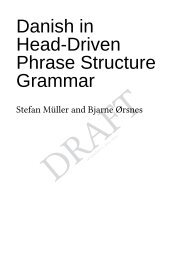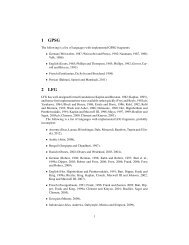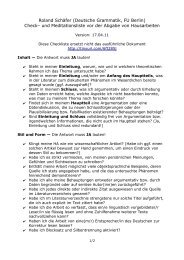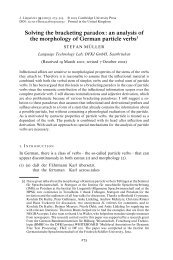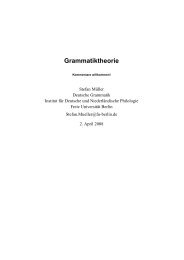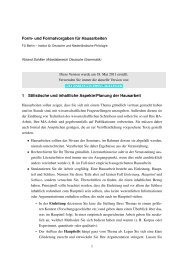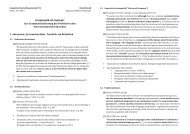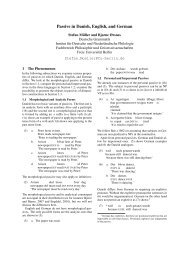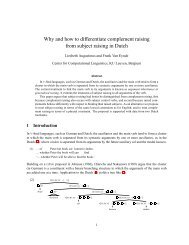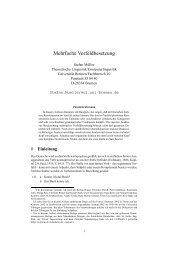Nonverbal Predicates in Modern Hebrew - German Grammar Group ...
Nonverbal Predicates in Modern Hebrew - German Grammar Group ...
Nonverbal Predicates in Modern Hebrew - German Grammar Group ...
Create successful ePaper yourself
Turn your PDF publications into a flip-book with our unique Google optimized e-Paper software.
this means that the rule imposes the constra<strong>in</strong>ts of cop-sign (and pres-cop-struct) without attach<strong>in</strong>g Pron.<br />
This analysis of zero copulas enables us to account for cases of complement extraction such as those<br />
discussed by Bender (2001), as well as for sentences such as (8) below where a predicate is extracted<br />
from a zero-copula construction, leav<strong>in</strong>g beh<strong>in</strong>d an adverb.<br />
(8) eifo ata xoshev she-dani axshav?<br />
where you.2SM th<strong>in</strong>k.SF that-Dani now<br />
‘Where do you th<strong>in</strong>k Dani is now?’<br />
We thus provide a unified analysis for the three types of copulas <strong>in</strong> <strong>Modern</strong> <strong>Hebrew</strong> (Pron, the verb-like<br />
haya, and the empty copula) <strong>in</strong> terms of agreement, constituent structure, and semantics.<br />
The analysis is implemented with the LKB system (Copestake 2002). We <strong>in</strong>tegrated <strong>in</strong>to the grammar<br />
a wide-coverage morphological processor of <strong>Hebrew</strong> (Itai & W<strong>in</strong>tner 2008), thereby obta<strong>in</strong><strong>in</strong>g<br />
broad coverage and robustness. The grammar now <strong>in</strong>cludes over 30 thousand lemmas, or some 150,000<br />
<strong>in</strong>flected forms.<br />
The grammar design employed <strong>in</strong> our implementation makes a dist<strong>in</strong>ction between the parse tree<br />
and the constituent structure (Haugereid & Morey 2012). The parse tree is left-branch<strong>in</strong>g, and is built<br />
<strong>in</strong>crementally (9). Each step of the parse is licensed by a structure, a subtype of sign. Structures have<br />
an ARGS list consist<strong>in</strong>g of either one or two members. The first member describes the str<strong>in</strong>g parsed<br />
so far, and various features of this str<strong>in</strong>g are used to constra<strong>in</strong> the properties of the follow<strong>in</strong>g word.<br />
These constra<strong>in</strong>ts are encoded <strong>in</strong> the second member of the ARGS list. An additional feature, VBL, is<br />
used to record whether a verb is still required, and if so, to pose constra<strong>in</strong>ts on that verb. Although the<br />
parse tree is strictly left-branch<strong>in</strong>g, the grammar builds a (standard) constituent structure that encodes<br />
the appropriate semantic structure (10). The constituent structure we assume is relatively flat.<br />
(9) struct<br />
(10) S<br />
struct<br />
N<br />
NP<br />
V<br />
NP<br />
struct<br />
V<br />
N<br />
N<br />
START<br />
N<br />
To test the grammar, we created a test suite of positive and negative items <strong>in</strong> the format of [<strong>in</strong>cr<br />
tsdb()] (Oepen & Flick<strong>in</strong>ger 1998). The suite tests agreement between the subject and the predicate,<br />
agreement between the subject and the copula, empty copula constructions, word order alternations, and<br />
subject and predicate extraction (<strong>in</strong>clud<strong>in</strong>g extraction from subord<strong>in</strong>ate clauses). Our grammar fully<br />
covers the positive items, assign<strong>in</strong>g the correct expected syntactic and semantic structures to all of them.<br />
In terms of negative examples, the grammar slightly overgenerates. This is due to the fact that the<br />
b<strong>in</strong>ary copula construction is allowed to <strong>in</strong>sert a Pron after the predicate and the subject. While this<br />
is grammatical for regular verbs, <strong>in</strong>clud<strong>in</strong>g haya and its <strong>in</strong>flected forms, it is strongly questionable for<br />
Pron. We have not yet decided whether or not this should be ruled out by the grammar.<br />
Acknowledgments<br />
This research was supported by THE ISRAEL SCIENCE FOUNDATION (grant No. 505/11).<br />
5




